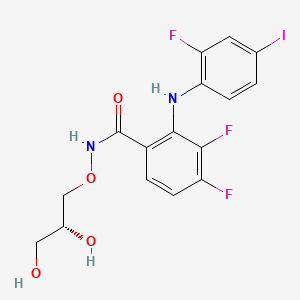Drug Information
Drug (ID: DG00205) and It's Reported Resistant Information
| Name |
PD-0325901
|
||||
|---|---|---|---|---|---|
| Synonyms |
PD 0325901; PD 325901; PD0325901; PD325901; PD-325901; S06-0029; N-[((R)-2,3-dihydroxypropyl)oxy]-3,4-difluoro-2-[(2-fluoro-4-iodophenyl)amino]benzamide; N-[(2R)-2,3-dihydroxypropoxy]-3,4-difluoro-2-[(2-fluoro-4-iodo-phenyl)amino]benzamide; N-{[(2R)-2,3-dihydroxypropyl]oxy}-3,4-difluoro-2-[(2-fluoro-4-iodophenyl)amino]benzamide
Click to Show/Hide
|
||||
| Indication |
In total 1 Indication(s)
|
||||
| Structure |

|
||||
| Drug Resistance Disease(s) |
Disease(s) with Clinically Reported Resistance for This Drug
(2 diseases)
[1]
[1]
|
||||
| Target | MAPK/ERK kinase kinase (MAP3K) | NOUNIPROTAC | [1] | ||
| Click to Show/Hide the Molecular Information and External Link(s) of This Drug | |||||
| Formula |
C16H14F3IN2O4
|
||||
| IsoSMILES |
C1=CC(=C(C=C1I)F)NC2=C(C=CC(=C2F)F)C(=O)NOC[C@@H](CO)O
|
||||
| InChI |
1S/C16H14F3IN2O4/c17-11-3-2-10(16(25)22-26-7-9(24)6-23)15(14(11)19)21-13-4-1-8(20)5-12(13)18/h1-5,9,21,23-24H,6-7H2,(H,22,25)/t9-/m1/s1
|
||||
| InChIKey |
SUDAHWBOROXANE-SECBINFHSA-N
|
||||
| PubChem CID | |||||
| ChEBI ID | |||||
| TTD Drug ID | |||||
| DrugBank ID | |||||
Type(s) of Resistant Mechanism of This Drug
Drug Resistance Data Categorized by Their Corresponding Diseases
ICD-02: Benign/in-situ/malignant neoplasm
| Drug Resistance Data Categorized by Their Corresponding Mechanisms | ||||
|
|
||||
| Key Molecule: MAPK/ERK kinase 2 (MEK2) | [1] | |||
| Molecule Alteration | Missense mutation | p.V215E |
||
| Resistant Disease | Colorectal cancer [ICD-11: 2B91.1] | |||
| Experimental Note | Identified from the Human Clinical Data | |||
| Cell Pathway Regulation | RAS/RAF/MEk signaling pathway | Activation | hsa04010 | |
| In Vitro Model | MDA-MB-231 cells | Breast | Homo sapiens (Human) | CVCL_0062 |
| HCT-116 MEk-R cells | Colon | Homo sapiens (Human) | CVCL_V401 | |
| Experiment for Molecule Alteration |
Exome sequencing assay | |||
| Experiment for Drug Resistance |
BrdUrd assay | |||
| Mechanism Description | The RAS/RAF/MEk pathway is activated in more than 30% of human cancers, most commonly via mutation in the k-ras oncogene and also via mutations in BRAF. Importantly, in all cases the MEk-resistant cell lines retained their addiction to the mitogen-activated protein kinase (MAPk) pathway, as evidenced by their sensitivity to a selective inhibitor of the ERk1/2 kinases. These data suggest that tumors with acquired MEk inhibitor resistance remain dependent on the MAPk pathway and are therefore sensitive to inhibitors that act downstream of the mutated MEk target. | |||
| Key Molecule: MAPK/ERK kinase 1 (MEK1) | [1] | |||
| Molecule Alteration | Missense mutation | p.F129L |
||
| Resistant Disease | Colorectal cancer [ICD-11: 2B91.1] | |||
| Experimental Note | Identified from the Human Clinical Data | |||
| Cell Pathway Regulation | RAS/RAF/MEk signaling pathway | Activation | hsa04010 | |
| In Vitro Model | MDA-MB-231 cells | Breast | Homo sapiens (Human) | CVCL_0062 |
| HCT-116 MEk-R cells | Colon | Homo sapiens (Human) | CVCL_V401 | |
| Experiment for Molecule Alteration |
Exome sequencing assay | |||
| Experiment for Drug Resistance |
BrdUrd assay | |||
| Mechanism Description | The RAS/RAF/MEk pathway is activated in more than 30% of human cancers, most commonly via mutation in the k-ras oncogene and also via mutations in BRAF. Importantly, in all cases the MEk-resistant cell lines retained their addiction to the mitogen-activated protein kinase (MAPk) pathway, as evidenced by their sensitivity to a selective inhibitor of the ERk1/2 kinases. These data suggest that tumors with acquired MEk inhibitor resistance remain dependent on the MAPk pathway and are therefore sensitive to inhibitors that act downstream of the mutated MEk target. | |||
| Drug Resistance Data Categorized by Their Corresponding Mechanisms | ||||
|
|
||||
| Key Molecule: MAPK/ERK kinase 1 (MEK1) | [1] | |||
| Molecule Alteration | Missense mutation | p.L115P |
||
| Resistant Disease | Breast cancer [ICD-11: 2C60.3] | |||
| Experimental Note | Identified from the Human Clinical Data | |||
| Cell Pathway Regulation | RAS/RAF/MEk signaling pathway | Activation | hsa04010 | |
| In Vitro Model | MDA-MB-231 cells | Breast | Homo sapiens (Human) | CVCL_0062 |
| HCT-116 MEk-R cells | Colon | Homo sapiens (Human) | CVCL_V401 | |
| Experiment for Molecule Alteration |
Exome sequencing assay | |||
| Experiment for Drug Resistance |
BrdUrd assay | |||
| Mechanism Description | The RAS/RAF/MEk pathway is activated in more than 30% of human cancers, most commonly via mutation in the k-ras oncogene and also via mutations in BRAF. Importantly, in all cases the MEk-resistant cell lines retained their addiction to the mitogen-activated protein kinase (MAPk) pathway, as evidenced by their sensitivity to a selective inhibitor of the ERk1/2 kinases. These data suggest that tumors with acquired MEk inhibitor resistance remain dependent on the MAPk pathway and are therefore sensitive to inhibitors that act downstream of the mutated MEk target. | |||
References
If you find any error in data or bug in web service, please kindly report it to Dr. Sun and Dr. Zhang.
